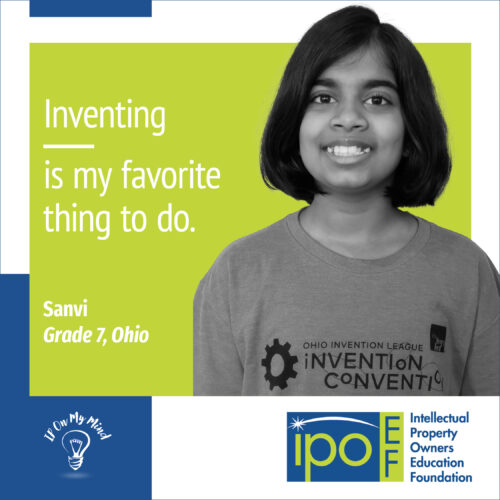
Intellectual Property Education Is Empowerment
Sanvi Keskar
Grade 7, Ohio

“My favorite subject in school is math, but inventing, I do 24/7. Inventing is my favorite thing to do,” exclaims Sanvi, a seventh-grade student from Delaware, Ohio. “In math, there’s a right answer and a wrong answer, but with inventing, there is more creativity, so you can do it your own way. There is not a specific way to invent.” While only in middle school, Sanvi has discovered the magic of inventing. A serial inventor, Sanvi has created a number of inventions, many of which solve problems in incredibly different fields. Through her recent invention, the Cafawaste X 2000, an eco-friendly smart waste bin, Sanvi has also begun learning about intellectual property (IP). Just like there’s no specific way to invent, Sanvi has also realized there’s no one-size-fits-all journey to pursuing IP ownership.
This past June, Sanvi presented her invention at Invention Convention U.S. Nationals 2023. Cafawaste X 2000 is a device that automatically sorts and filters school cafeteria and food court waste, like food, plates, and utensils, in a budget-friendly, safe, and convenient way. This invention directly helps the environment by reducing the amount of waste that goes into landfills. Prior to attending the national competition, Sanvi developed five prototypes of her invention – three that she created at home and two that she had manufactured professionally. Sanvi has always wanted to build professional versions of her inventions and she wanted to prove that the mechanism needed for her invention would work in the real world. It wasn’t easy to connect with manufacturers who would assist her in manufacturing her product. She reached out to various manufacturers and finally her persistence and patience paid off. Some manufacturers were interested in producing her invention. She worked with them to build professional working prototypes. Her family and mentors also acknowledged that they were concerned that Sanvi’s ideas might get stolen through communicating and working with multiple manufacturers. They told her that there were ways that Sanvi could protect her ideas, through intellectual property ownership.
Sanvi was surprised to learn that there are ways to own and protect her ideas. She was familiar with owning and protecting physical property, like houses, cars, or even something as small as a pencil. When someone owns a piece of physical property, they receive a receipt, deed, or certificate to prove its theirs, but Sanvi was amazed to find out that she could claim ownership of something that she couldn’t hold in her hands yet. “I now think of intellectual property as keeping something that doesn’t exist safe,” Sanvi explains.
In order to learn more about IP protection, Sanvi attended seminars at the Center of Science and Industry (COSI) in Columbus, Ohio. She also sought advice and guidance from her family, teachers, and Ohio Invention League mentors. “Protecting your ideas is important because it’s your idea. You’ve worked hard on it. You’ve tested it. You’ve done everything for it,” Sanvi explains, “It’s not fair for someone to take your idea. You want to be able to get IP ownership so you can keep inventing and no one can harm your idea.”
Through learning about intellectual property, Sanvi realized that there are many different ways to protect your ideas. To decide which type of intellectual property ownership she wanted, Sanvi had to consider how much protection she needed and which portions of her ideas she must be protected. She also needed to think about how much time, money, and resources she had available to apply for and maintain her intellectual property ownership. Ultimately, Sanvi filed a provisional patent application to protect her IP while she manufactured prototypes of her invention.
Sanvi needed more time to refine her invention before she was ready to apply for a full patent, but she still needed to protect her ideas in the meantime. By filing a provisional patent application, instead, Sanvi was able to find an affordable and accessible way to temporarily protect her intellectual property. A provisional patent application helps an inventor temporarily claim ownership of their idea for a 12-month period. During this time, an inventor can feel more secure in publicly communicating about their product to manufacturers or competition judges, while they continue to work on their prototype, begin marketing their product, or begin writing their full patent application. According to Sanvi, a provisional patent application is a type of intellectual property ownership that more student inventors should consider. “A provisional patent application buys you time while you’re planning your future with your invention” Sanvi explains. Sanvi is currently pursuing a full patent for her invention.
Sanvi hopes that more students are able to learn about inventing and intellectual property like she has. She recommends that educators teach intellectual property as part of a school curriculum through hands-on lessons. When she was learning about intellectual property, it was helpful for Sanvi to apply her new knowledge to her protect her invention. She believes that other students may find this approach effective as well. Beyond the classroom, there are also a wide variety of resources that educators and students may find helpful, including information sessions at local museums and libraries, and networking with mentors and IP owners through invention education programs and competitions for further advice about intellectual property protection.
As Sanvi learned about IP protection, she now teaches and shares that information with her friends and family. She has become a big supporter of IP protection and wants everyone to understand the importance of protecting their ideas.
As Sanvi continues to carve her own path in the world of inventing, she hopes that more people – including students like her – are able to bring their ideas to life. “Students, teachers, adults – they can all become inventors. Inventing is not something you have to study for,” Sanvi exclaims, “Everyone is creative in their own way. If there’s a problem you want to solve, just go for it. There’s no right or wrong in inventing!”




